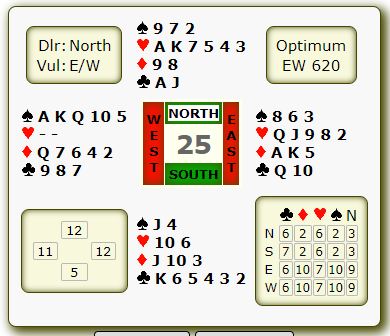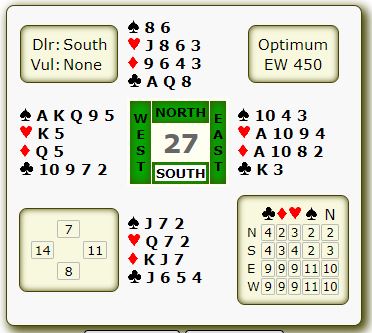Losing Trick CountAccording to LTC originator Ron Klinger, LTC can only be used after an 8+ card trump fit has been found or when one partner has a self-sufficient suit, and it is not suitable for use for notrump or misfit hands. Experts say that LTC is more reliable in early bidding and not for slam or other high contracts. According to Klinger, a suit is self-sufficient if the length of the suit plus the number of honors in it totals 8+. One example he gives is KQJT32. With such a suit, you can use LTC without having to find an 8-card fit with partner.
Counting Your LosersEverybody seems to have their own take on how to count losers. But Double Dummy Analysis done by BidBase usually indicates that LTC is not all that reliable, so BidBase has a more or less standard method of counting and that should be as good as anything. (The following is mostly from BridgeBum.) The number of losers is based on the first 3 cards (if that many) in a suit.
When there is a gap between counts shown below, count any holdings between them as the higher number of losers. Since AQJ is 1 loser and AJT is 1.5, then AQT to AQ2 ("AQx") holdings are 1.5 losers and any Ace holding below AJT (AJ9 to A32, or "Axx") is 2 losers.
Because of the way Winners and Losers are calculated, they normally do not add up to 13, as the names might suggest. The above is just one way to count losing tricks. As usual in bridge, there are alternatives. One is to simply count missing A, K, Q in 3+ card suits, A, K in doubletons, and A in singletons. Other options are to add a losing trick for an ace-less or king-less hand, not to count a Q of trumps as a loser (BB counts Q in Qxx as a half-loser). Another alternative is to adjust for what is indicated by bidding. For example, AQ=.5, but if RHO bid the suit, AQ=0 losers. If LHO bid it, AQ=1 loser. See the series Losing Trick Count, updated in Bridge Bulletin starting in May 2018. Google losing trick count for even more information. Figuring Partner's LosersLTC is only used when you and partner have at least 8 trumps between you. Clearly, LTC can only be used if partner names or implies a suit which matches yours, except that if you have an 8 card suit in your own hand and partner is bidding, you can use LTC. If partner's initial bid does not specify a suit, LTC cannot be used until he does specify one, then you would refer back to his initial bid to estimate his HCP and get the LTC from that. For example, if partner opens 1N and you have ...
Since different systems and conventions may specify different HCP ranges for bids, no attempt has been made to associate bid names with HCP ranges. Presumably, you know those ranges for your system. The column "JJ" is the LTC per Jennifer Jones in the 2018 Bulletin series.
Do The Math
Example:
LTC's 24 - 8 - 7 = 9 tricks. Despite 27 total HCPs, the 3 level is the limit. In hearts or NT, you lose 1 spade, 1 diamond, and 2 hearts if they are not 3-3.
27 HCP and you may go down in a part score. How can one stay out of game with so many points? On this deal, which is from the Bridge Bulletin, Mar.2017, p.38, #3, both pairs made game-forcing bids despite having more losing tricks than their HCP indicate they should have. In such a case, players should go the opposite direction and bid conservatively -- don't make game-forcing bids; don't go looking for 4-3 fits; don't steer into NT with no known fit or source of extra tricks. Examples at the Bridge Club:

Bidding (Dealer=North): 2 East's Limit Raise Cue Bid normally shows 4-card support, but otherwise seemed to be the most accurate. West's Losing Trick Count: S=0 + H=0 + D=3 + C=3 = 6
Bidding (NS passing):: 1 1N is forcing. 3S is a 3-card limit raise.
West's LTC = S=0 + H=.5 + D=2 + C=3 = 5.5
|



 A9
A9  984
984  KJT5
KJT5  AJ65 = 8 losing tricks (13 HCP)
AJ65 = 8 losing tricks (13 HCP)

